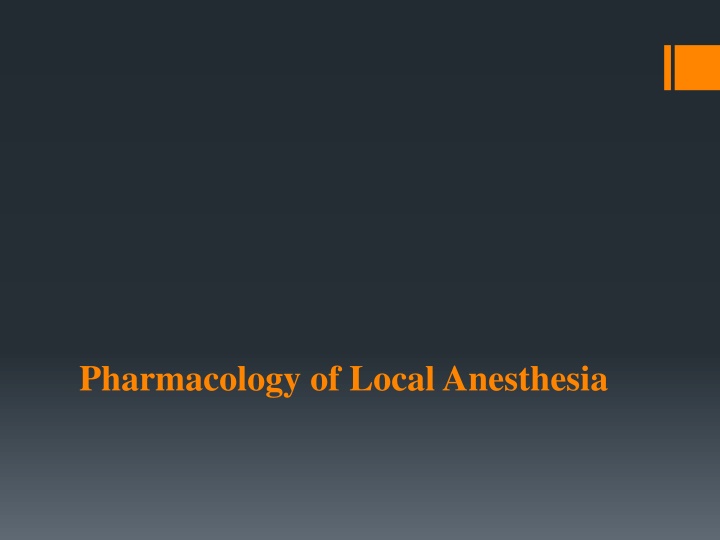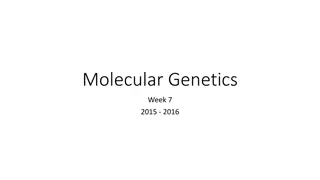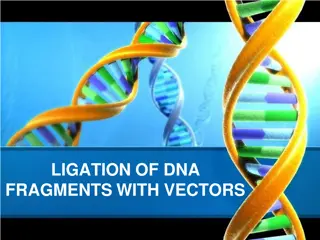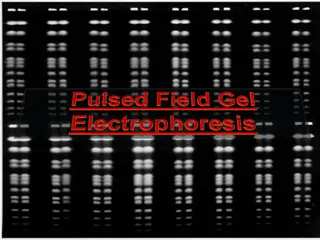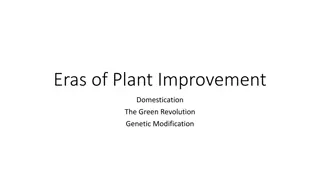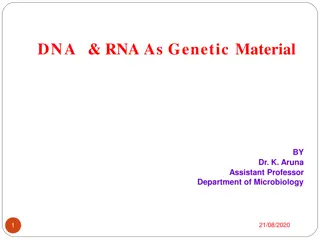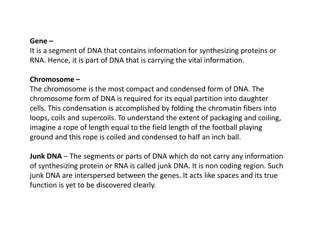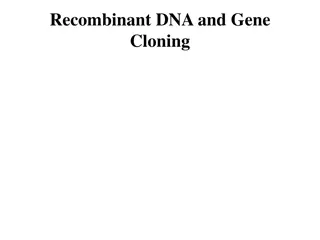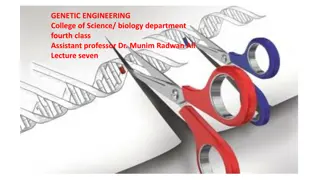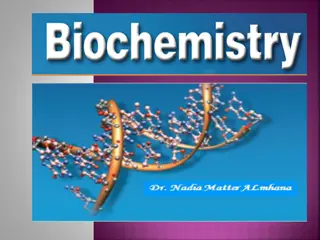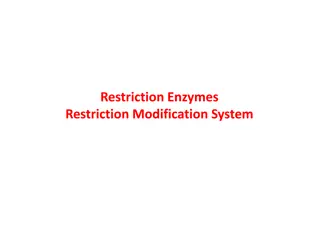Genetic Engineering: Manipulating DNA for Genetic Modification
Genetic engineering is a process that involves inserting new genetic information into existing cells to modify organisms, altering their characteristics by manipulating DNA. This direct genetic manipulation can involve changing genetic structure, transferring genes across species boundaries, and producing genetically modified organisms (GMOs). Scientists use biotechnology to alter genes in various organisms, from viruses to animals, for purposes such as research, medicine, industrial applications, biotechnology, and agriculture. The technology has been pivotal in developing GM crops, producing human insulin, growth hormones, enzymes, drugs, and vaccines, and studying gene function and expression. Genetic engineering has diverse applications and has seen significant advancements since its inception in the 1970s.
Uploaded on Apr 16, 2025 | 2 Views
Download Presentation

Please find below an Image/Link to download the presentation.
The content on the website is provided AS IS for your information and personal use only. It may not be sold, licensed, or shared on other websites without obtaining consent from the author.If you encounter any issues during the download, it is possible that the publisher has removed the file from their server.
You are allowed to download the files provided on this website for personal or commercial use, subject to the condition that they are used lawfully. All files are the property of their respective owners.
The content on the website is provided AS IS for your information and personal use only. It may not be sold, licensed, or shared on other websites without obtaining consent from the author.
E N D
Presentation Transcript
Local anesthetic cartilage contains the following ingredients 1) Local anesthetic agent 2) Vasoconstrictor 3) Preservative for the vasoconstrictor (Reducing agent) 4) Ringers solution 5) Distilled water 6) General preservative
Local anesthetics are drugs which upon topical application or local injection cause a reversible loss of sensory perception, especially of pain in a restricted area of the body, it provides pain control during dental therapy. These drugs are listed by their percentage (%) concentration. The number of mg of an agent contained in the cartridge can be calculated by multiplying the percentage (%) concentration by the number of ml in the cartridge. Thus, a cartridge containing 2ml of 2% local anesthetic solution contains 40 mg of the local anesthetic agent (2% mean that for each ml there is 20 mg, if the cartilage contains 2 ml then 20x2=40 mg of the local anesthetic agent in a single cartilage).
Classification of local anesthetics 1 - on the basis of occurrence in nature I. Natural (e.g. cocaine) II. Synthetic (e.g. lignocaine) 2- on the basis of duration of action I. Short-acting (e.g. articaine, lidocaine) II. Long-acting (e.g. bupivacaine) 3- on the basis of chemical structure I. Ester (e.g. Procaine, Cocaine, Benzocaine) II. Amide (e.g. Lidocaine, Prilocaine, Articaine)
Pharmacokinetic of local anesthesia (Distribution,Metabolism & Excretion) Distribution: Once absorbed into the blood, local anesthetics are distributed throughout the body to all tissues.Highly perfused organs (and areas), such as the brain, head, liver,kidneys, lungs, and spleen, initially will have higher anesthetic blood levels than less highly perfused organs. Skeletal muscle, although not as highly perfused as these areas, contains the greatest percentage of local anesthetic of any tissue or organ in the body because it constitutes the largest mass of tissue in the body. The blood level of local anesthetic is influenced by the following factors: 1. The rate at which the drug is absorbed into the cardiovascular system. 2. The rate of distribution of the drug from the vascular compartment to the tissues (more rapid in healthy patients than in those who are medically compromised as congestive heart failure patients). 3. Elimination of the drug through the metabolic or excretory pathways.
Metabolism A-Ester local anesthetics 1) Ester local anesthetics are hydrolyzed in the plasma by the enzyme pseudocholinesterase. 2) Peoples having an atypical form of pseudocholinesterase get inability to hydrolyze ester local anesthetics, thus prolongation of higher blood levels of the local anesthetic and an increased potential for toxicity. B -Amide local anesthetics 1) The metabolism of the amide type is more complex and somewhat slower than that of the ester type, it appears that breakdown does not occur in the bloodstream and that hydrolysis takes place mainly in the presence of catalysts in the liver, the product is then excreted in the urine. 2) Excretion: The kidney is the primary organ for both the local anesthetics and its metabolites. A percentage of a given dose of the local anesthetic drug will be excreted unchanged in the urine and this varies according to the drug
Excretion: The kidney is the primary organ for both the local anesthetics and its metabolites. A percentage of a given dose of the local anesthetic drug will be excreted unchanged in the urine and this varies according to the drug.
Lignocaine (Lidocaine, Xylocaine) Lignocaine: is the most commonly used local anesthetic agent in dentistry, it is stable as it can be stored for a long time at room temperature, it is compatible with all types of vasoconstrictors. Classification:Amide. Metabolism: in the liver. Excretion: Via the kidneys. Vasodilating Properties: Considerably less than those of procaine; however, greater than those of mepivacaine. The onset ofAction: Rapid (3 to 5 minutes). Effective Dental Concentration: 2%. Anesthetic Half-Life: (90 minutes). TopicalAnestheticAction: (with a concentration of 5% or 10%). Availability in dentistry: dental cartridge of 2% lidocaine with or without epinephrine.
Maximum Recommended Dose The maximum recommended dose of lidocaine with epinephrine (1:100.000) is 7 mg/kg. While 4.5 mg/kg is the maximum dose of lidocaine without epinephrine. In all the cases not to exceed an absolute maximum dose of 500mg. Allergy to amide local anesthetics is extremely rare; although possible, this is a major clinical advantage of lidocaine and all amides over ester-type local anesthetics.
1-Central Nervous System Local anesthetics readily cross the blood-brain barrier. Their pharmacologic action on the CNS is one of depression. At low (therapeutic, nontoxic) blood levels, no CNS effects of any clinical significance have been noted. At higher (toxic, overdose) levels the primary clinical manifestation is a generalized tonic-clonic convulsion. Between these two extremes exists a spectrum of other clinical signs and symptoms
Preconvulsive Signs and Symptoms of Central Nervous System Toxicity Signs (Objectively Observable) I. Slurred speech II. Shivering III. Muscular twitching IV. Tremor of muscles of face and distal extremities V. Dizziness VI. Visual disturbances (inability to focus) VII. Auditory disturbance (tinnitus) VIII.Drowsiness IX. Disorientation
Symptoms (Subjectively Felt) I. Numbness of tongue and circumoral region II. Warm, flushed feeling of skin
2-Cardiovascular System Local anesthetics have a direct action on the myocardium and peripheral vasculature. In general, however, the CVS is more resistant than the CNS to the effects of local anesthetic drugs Local anesthetics modify electrophysiologic events in the myocardium in a manner similar to their actions on peripheral nerves. As the local anesthetic blood level increases, the rate of rise of various phases of myocardial depolarization is reduced. Local anesthetics produce a myocardial depression related to the local anesthetic blood level. Local anesthetics decrease the electrical excitability of the myocardium, decrease conduction rate, and decrease the force of contraction.
3-Respiratory System Local anesthetics exert a dual effect on respiration. At non overdose levels, they have a direct relaxant action on bronchial smooth muscle, whereas at overdose levels, they may produce respiratory arrest as a result of generalized CNS depression. In general, respiratory function is unaffected by local anesthetics until near- overdose levels are achieved.
4-Miscellaneous Actions Drug Interactions In general, CNS depressants (e.g., opioids, antianxiety drugs, barbiturates) when administered in conjunction with local anesthetics lead to potentiation of the CNS depressant actions of the local anesthetic. Prolonged apnea may result from concomitant use of these drugs. Drugs that induce the production of hepatic microsomal enzymes (e.g., barbiturates) may alter the rate at which amide local anesthetics are metabolized.
